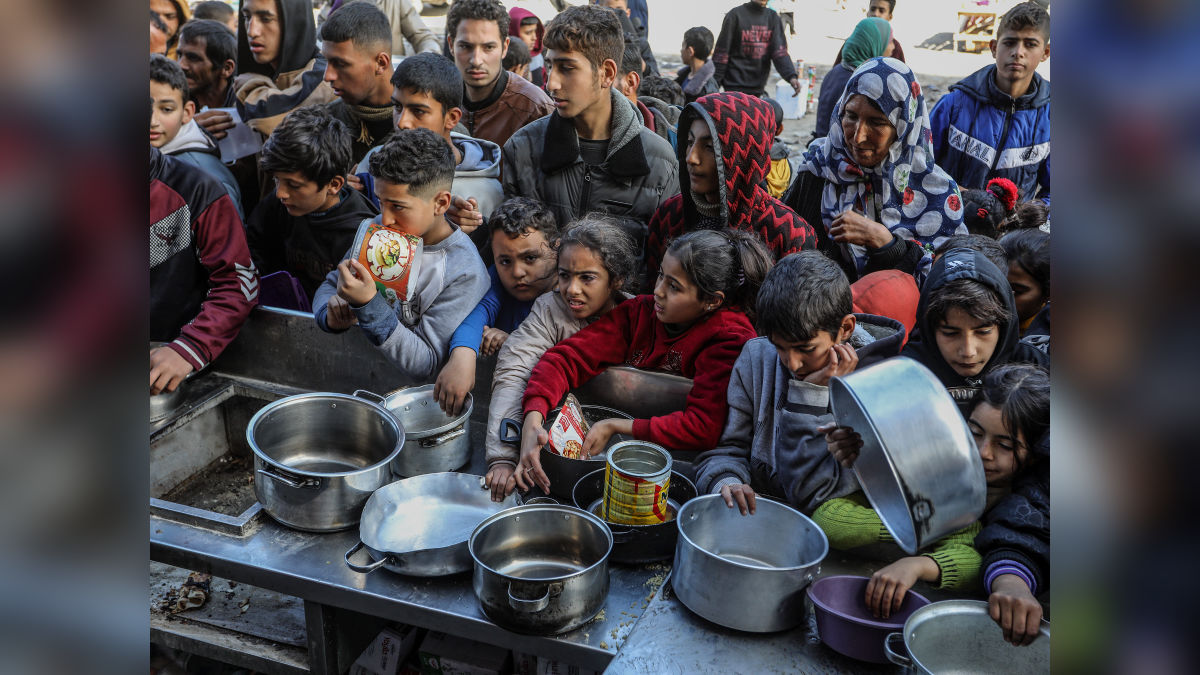Gaza has been on the brink of famine for months.
Palestinians are said to be starving.
Israel in May relaxed an over two month blockade on the Gaza strip.
However, aids groups say not enough food is getting through.
They Palestinians are facing unimaginable levels of hunger.
Meanwhile, Israeli forces have killed hundreds trying to get to aid sites and convoys – though the military denies this.
So why hasn’t a famine been declared?
The crisis
Nearly all the 2 million Palestinians in the Gaza strip depend on outside aid.
Local food production was extremely limited prior the Israeli offensive.
It has since been completely eradicated.
The blockade imposed by Israel is making things worse.The UN World Food Program says Gaza’s hunger crisis has reached “new and astonishing levels of desperation.”
They say around 100,000 women and children are suffering from severe acute malnutrition.
Around one-third of Gaza’s population is spending days without eating, according to UN director for emergencies Ross Smith.
On Tuesday alone over 100 people suffering hunger and malnutrition died – though the cause was not officially listed as such.
Most of these were children.
When is a famine declared?
The Integrated Food Security Phase Classification (IPC) is widely regarded as the leading international authority on food crises.
The IPC was established during the Somalia famine in 2004.
It comprises several UN agencies, aid groups, governments and other bodies.
It says famine can appear in pockets — sometimes small ones — and a formal classification requires caution.
The IPC has only declared famine on only a handful of occasions.
This includes Somalia in 2011, and South Sudan in 2017 and 2020, and last year in parts of Sudan’s western Darfur region.
Tens of thousands are believed to have died in Somalia and South Sudan.
It classifies an area as being in famine when all three of these conditions are confirmed:
Twenty per cent of households have an extreme lack of food, or are essentially starving.
At least 30 per cent of children six months to five years old suffer from acute malnutrition or wasting, meaning they’re too thinfor their height.
At least two people or four children under five per 10,000 are dying daily due to starvation or the interaction of malnutrition and disease.
Gaza, meanwhile, is an even bigger challenge for experts.
This is because access to the strip is severely limited – making gathering reliable information nearly impossible.
Governments usually declare famine
Famine declarations usually are usually made by the governments themselves or the United Nations.
While the IPC says it is the “primary mechanism” used by the international community to conclude whether a famine is happening or projected, it typically doesn’t make such a declaration itself.
Often, UN officials together with governments will make a formal statement based on an analysis from the IPC.
But the IPC says once a famine is declared it’s already too late. While it can prevent further deaths, it means many people will have died by the time a famine is declared.
Hunger as cause of death?
Most cases of severe malnutrition in children arise through a combination of lack of nutrients along with an infection, leading to diarrhea and other symptoms that cause dehydration, said Alex de Waal, author of “Mass Starvation: The History and Future of Famine” and executive director of the World Peace Foundation.
“There are no standard guidelines for physicians to classify cause of death as ‘malnutrition’ as opposed to infection,” he said.
When famine occurs, there are often relatively few deaths from hunger alone, with far more people dying from a combination of malnutrition, disease and other forms of deprivation. All of these count as excess deaths — separate from violence — that can be attributed to a food crisis or famine, he said.
Reliable information is hard to find
Israel’s offensive has gutted Gaza’s health system and displaced some 90 per cent of its population. With hospitals damaged and overwhelmed by war casualties, it can be difficult to screen people for malnutrition and collect precise data on deaths.
“Data and surveillance systems are incomplete and eroded,” said James Smith, an emergency doctor and lecturer in humanitarian policy at the University College London who spent more than two months in Gaza.
“Which means that all health indicators — and the death toll — are known to be an underestimation,” he said.
‘Not a huge bank account’
A declaration of famine should in theory galvanize the international community to rush food to those who need it. But with aid budgets already stretched, and war and politics throwing up obstacles, that doesn’t always happen.
“There is not a big, huge bank account” to draw on, said OCHA’s Laerke. “The fundamental problem is that we build the fire engine as we respond.”
Aid groups say plenty of food and other aid has been gathered on Gaza’s borders, but Israel is allowing only a small amount to enter. Within Gaza, gunfire, chaos and looting have plagued the distribution of food.
The Israeli military says it has facilitated the entry of some 4,500 aid trucks since mid-May. That’s far below the 600 trucks a day that aid groups say are needed, and which entered during a six-week ceasefire earlier this year. An Israeli-backed American contractor is also distributing food.
UN agencies say Israeli restrictions, and the breakdown of law and order, make it difficult to distribute the food that does come in.
“Only a massive scale-up in food aid distributions can stabilize this spiraling situation, calm anxieties and rebuild the trust within communities that more food is coming,” the World Food Program said over the weekend. “An agreed ceasefire is long overdue.”
)